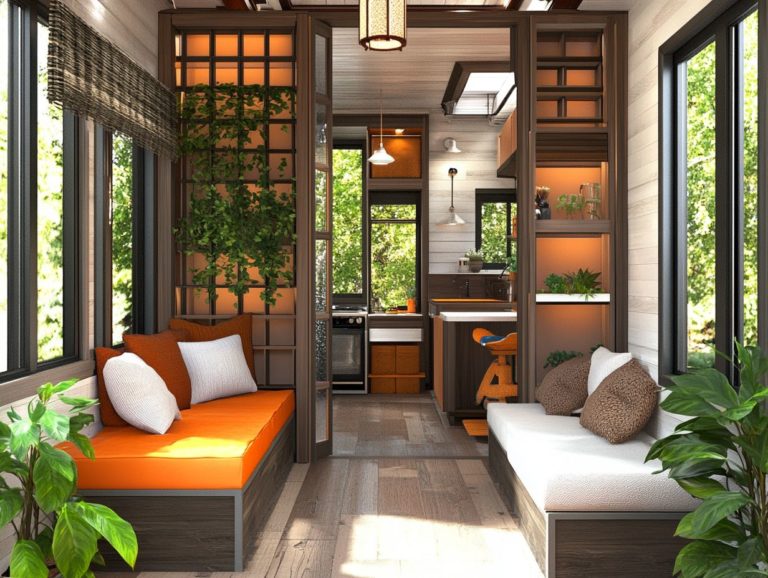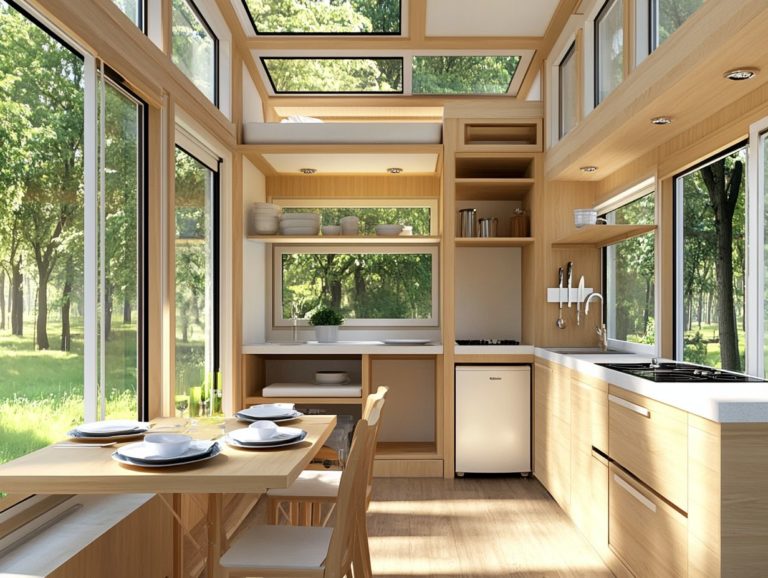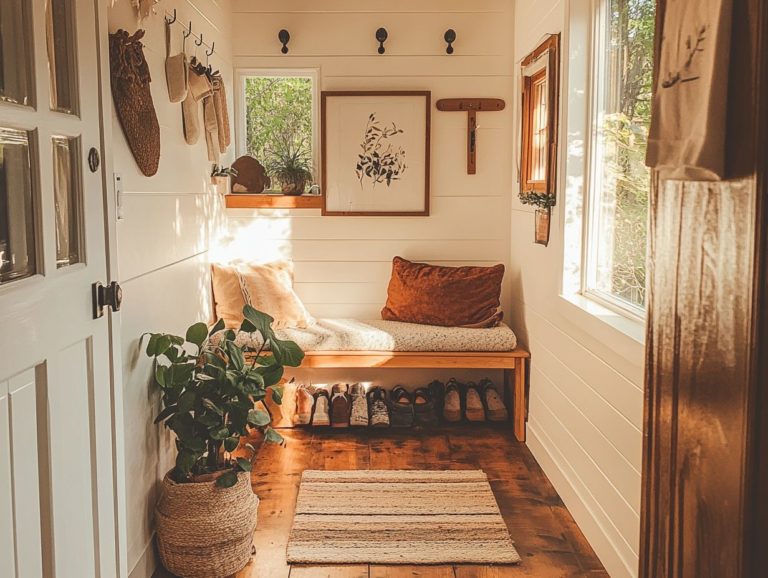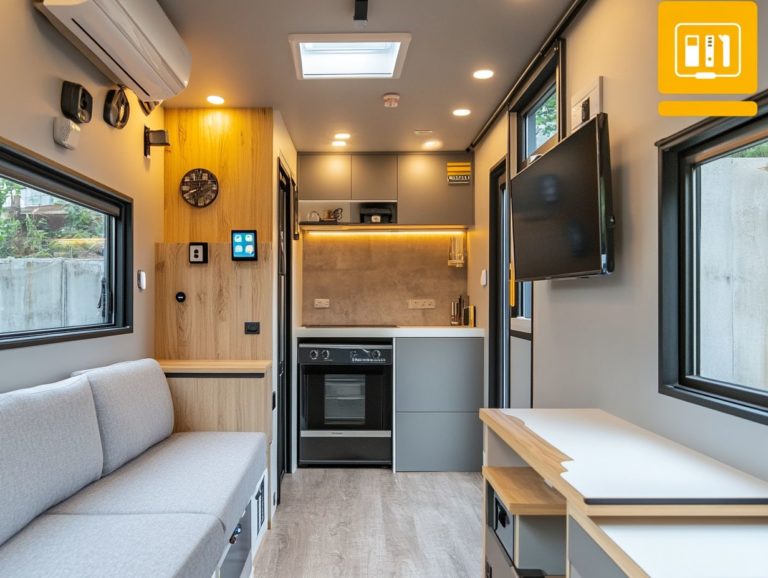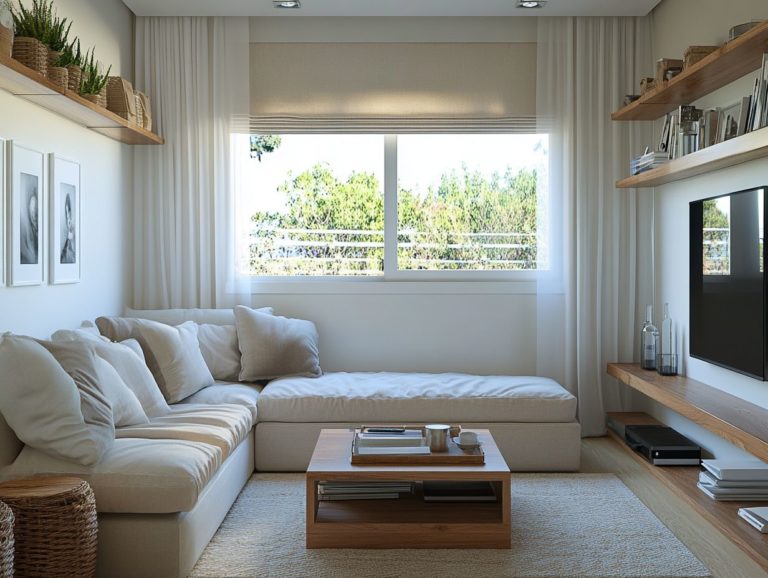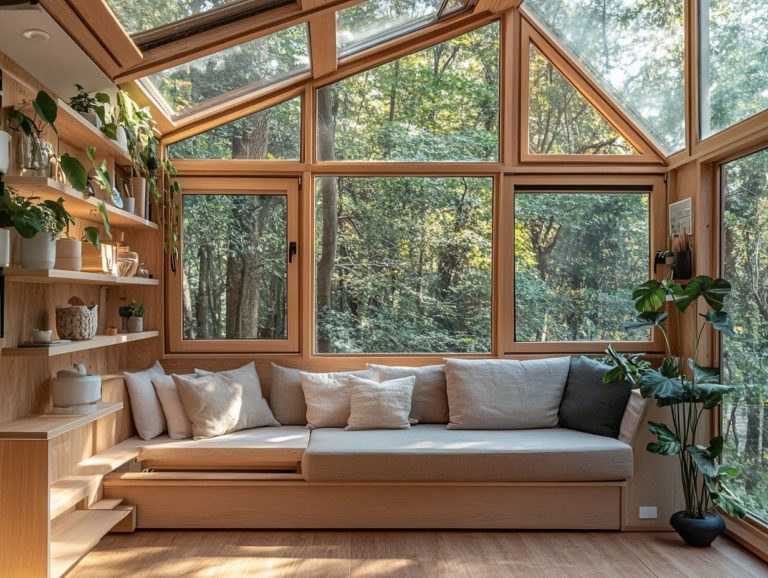Creating a Tiny Home for Everyday Living
Tiny homes represent a big change toward a simpler, more sustainable lifestyle.
This exploration will cover the essence of tiny homes and the myriad benefits they provide, ranging from significant financial savings to environmental advantages. It encompasses effective design strategies, the intricacies of the planning process, and practical solutions that make tiny living genuinely livable.
Whether you re contemplating a downsizing move or merely intrigued by the movement, you ll discover valuable insights and inspiration to guide you through your tiny home journey.
Contents [hide]
Key Takeaways:
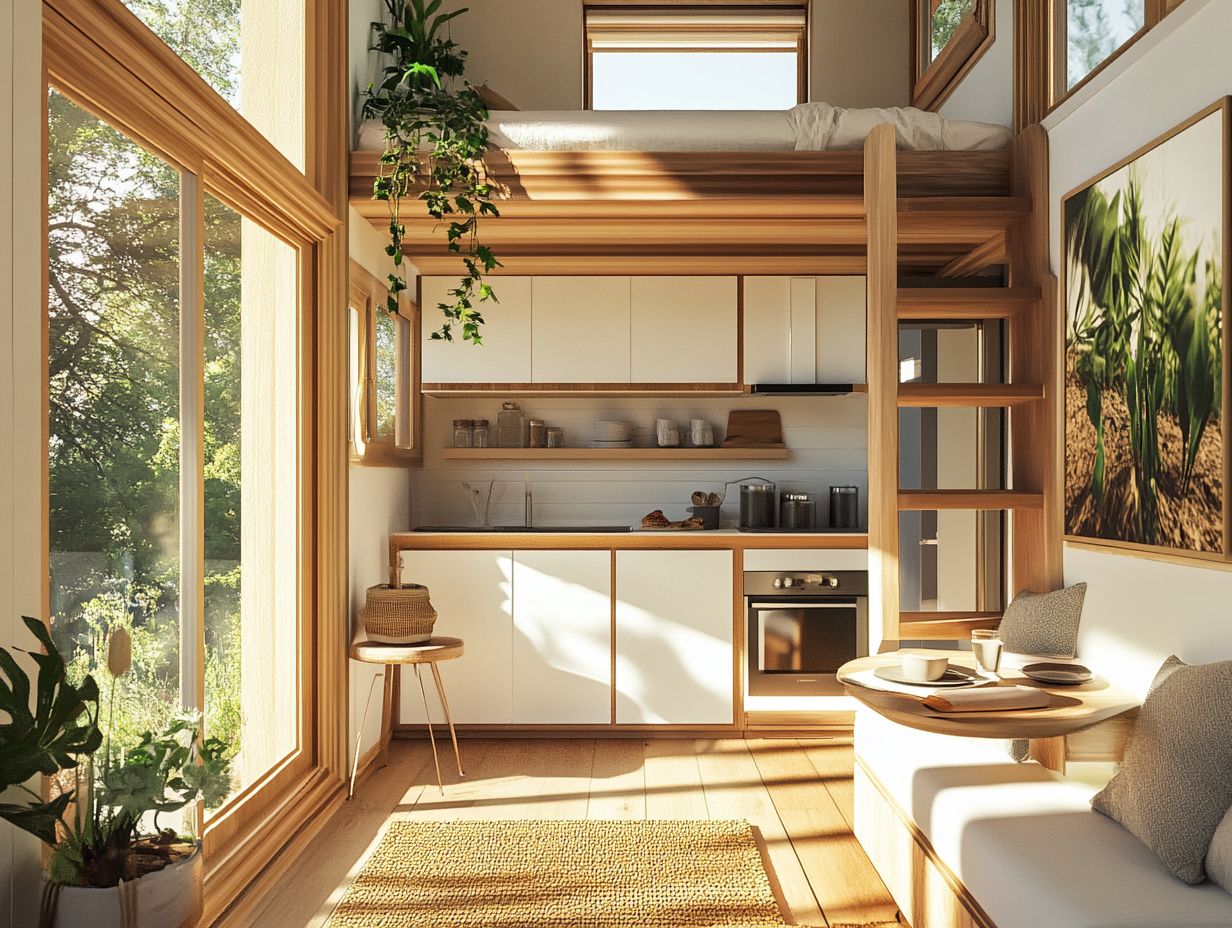
- Living in a tiny home offers both financial and environmental benefits, making it a sustainable lifestyle choice.
- When designing a tiny home, prioritize maximizing space and incorporating sustainable materials to create a functional and eco-friendly living space.
- Before building a tiny home, research and plan for permits, regulations, and location. Utilize storage solutions and multi-purpose furniture while maintaining a minimalist lifestyle to make it livable.
What is a Tiny Home?
A tiny home is a small living space that focuses on quality over quantity. It promotes financial freedom by encouraging minimalism and smart resource use.
Typically ranging from 100 to 400 square feet, these homes are designed for a minimalist lifestyle, allowing you to prioritize your practical needs and values while living sustainably. Many individuals opt for a DIY approach, crafting a personalized sanctuary with reclaimed materials that reflect their eco-conscious beliefs. For those looking to maximize space, learning how to create a multi-functional tiny house can be incredibly beneficial.
This trend is taking off, drawing on historical examples where small, efficient homes were common due to economic necessity. Today’s tiny homes boast a range of customizable features, from foldable furniture to expandable living areas, and incorporating ideas from designing a tiny house for entertaining, reflecting your unique tastes and lifestyle choices.
As awareness of environmental issues rises, more individuals feel compelled to downsize, eager to minimize their carbon footprint. With urban areas growing increasingly crowded and expensive, the allure of these minimalist dwellings continues to expand, offering a practical solution for those seeking simplicity and sustainability in their lives. To make the most of these spaces, it’s essential to learn how to create a functional tiny house layout.
Benefits of Living in a Tiny Home
Embracing life in a tiny home presents a wealth of advantages that resonate with contemporary ideals of minimalism, financial freedom, and sustainable living.
It’s an appealing choice for individuals and families eager to downsize and streamline their lives.
Financial Advantages
One of the most compelling financial advantages of living in a tiny home is the potential for significant cost savings, paving the way for greater financial freedom and reducing burdens over time.
By downsizing to a smaller space, you ll likely find your mortgage payments drop considerably. This eases monthly stress and eliminates hidden costs that come with larger homes, like higher property taxes and insurance.
Utilities in tiny homes are also delightfully lower; with less square footage, you’ll enjoy reduced heating, cooling, and water expenses. Plus, the simplified maintenance that tiny homes offer means fewer repair costs and upkeep headaches. Incorporating smart design solutions for tiny house living is a sustainable choice for those wanting to embrace affordability while enjoying a comfortable lifestyle.
Environmental Benefits
The environmental benefits of living in a tiny home are truly remarkable. These homes typically require fewer resources to build and maintain, which not only promotes sustainable living but also significantly reduces overall energy consumption.
This lifestyle encourages you to rethink your consumption patterns and prioritize quality over quantity. By embracing minimalism, you ll likely find yourself making eco-conscious choices in every aspect of your life whether it s sourcing sustainable materials for your home or opting for energy-efficient appliances.
Tiny homes take up less land, helping preserve green spaces and minimizing your ecological footprint. Ultimately, living in a tiny home fosters a deeper connection to the environment, inspiring you to engage in practices that protect natural resources while cultivating a more mindful existence.
Ready to explore the tiny home lifestyle further? Join a community or start your journey today!
Designing Your Tiny Home
Designing your tiny home is an exhilarating journey that focuses on maximizing both space and functionality. It offers you the opportunity to customize every detail to align with your unique needs and preferences.
Often, this process involves incorporating sustainable materials and innovative design principles that enhance your living experience and reflect your values.
Maximizing Space and Functionality
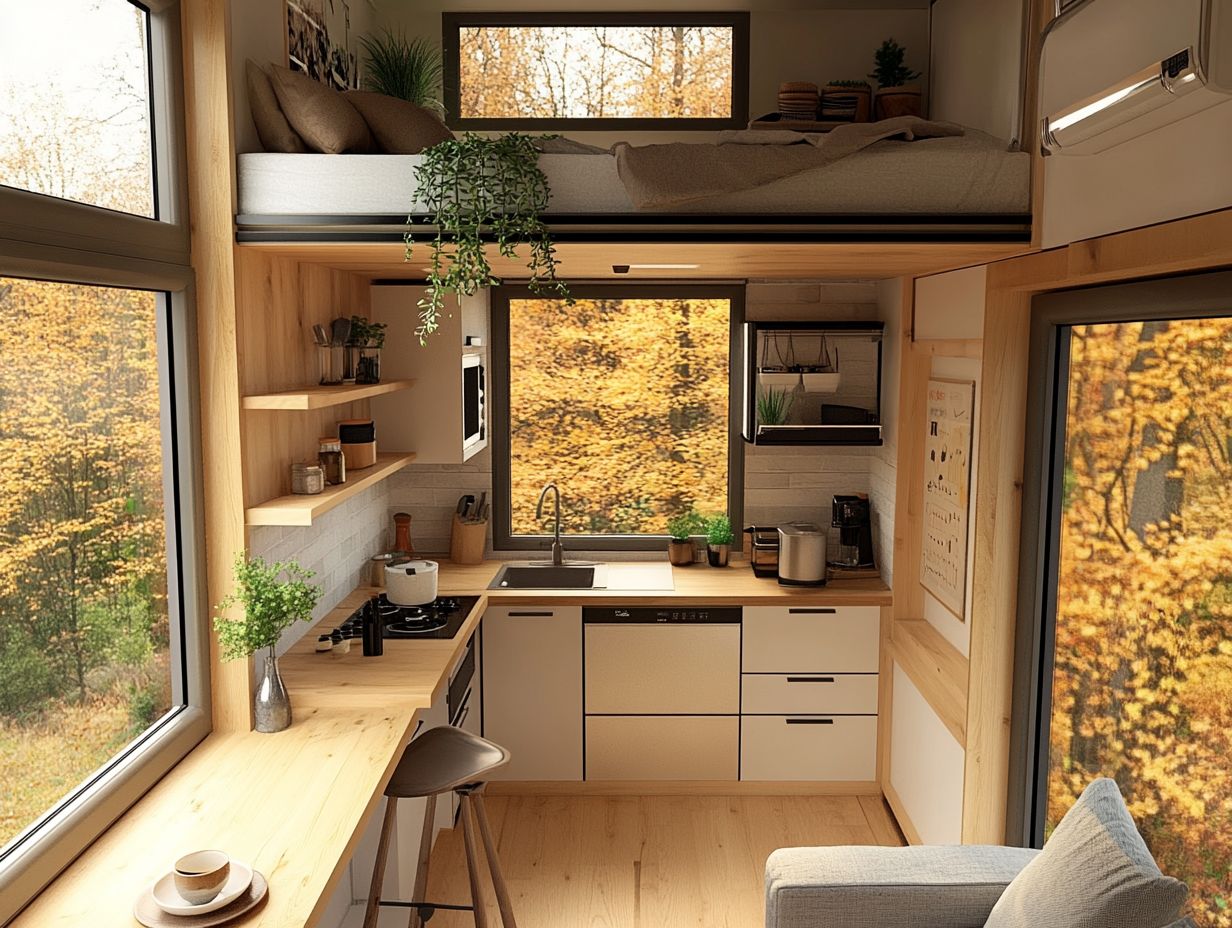
Maximizing the space and functionality in your tiny home requires a blend of strategic planning and innovative design solutions. This ensures that every square foot serves a purpose. Multi-functional furniture becomes your best friend in the realm of compact living.
To truly optimize your limited area, consider:
- Folding tables that transition from workspaces by day to dining areas by night.
- Sofas that transform into cozy beds for guests.
- Vertical storage solutions that free up valuable floor space while keeping your essentials easily accessible.
Don t overlook those under-stair compartments; they can turn often-neglected nooks into practical storage havens. This ensures your tiny home remains both stylish and functional.
Each aspect of your layout should harmonize with the overall design. This creates a seamless flow that enhances your daily living experience.
Incorporating Sustainable Materials
Incorporating sustainable materials into your tiny home design enhances both the aesthetic appeal and aligns beautifully with eco-friendly principles. This thoughtful approach promotes a healthier environment while supporting beautiful design.
Choosing reclaimed wood, recycled metal, and finishes that don’t have harmful chemicals plays a crucial role in reducing waste and conserving natural resources. This mindful selection minimizes the carbon footprint linked to new materials, all while infusing your living space with unique character and history.
These eco-friendly choices illustrate a balance between modern design and responsible living. Your home becomes a testament to a lifestyle that prioritizes sustainability, marrying form and function while paving the way for future generations.
Planning and Building Your Tiny Home
When you embark on the journey of planning and constructing your tiny home, you ll navigate a myriad of building options. Securing the necessary permits and adhering to regulations is essential.
Every choice you make about location will reflect your personal needs and shape your overall building experience.
Permits and Regulations
Understanding permits and regulations is vital for anyone starting the tiny house journey. These rules dictate building codes, zoning laws, and other legal considerations that are essential for successful construction.
These regulations can vary significantly depending on your location. Thus, navigating local ordinances and guidelines is necessary. From obtaining the required building permits to ensuring compliance with safety standards, it s crucial for those interested in tiny living to grasp the full scope of the legal requirements involved.
By adhering to these building codes, you not only make the construction process smoother but also align with the core principles of the tiny house movement. This movement emphasizes sustainable living and community integration.
Ultimately, respecting zoning laws allows you to contribute to emerging trends in alternative housing while embracing a lifestyle that prioritizes minimalism and eco-friendliness.
Choosing a Location
Choosing the right location for your tiny home is an important choice that shapes not only your lifestyle but also your connection to the community.
It’s crucial to scrutinize local zoning regulations, which are the rules about what you can build where, as these can significantly affect whether your chosen site is suitable for a tiny dwelling.
Engaging with potential neighbors can offer valuable insights into community values and support systems that are essential for feeling truly at home in your new environment.
Grasping the dynamics of land ownership whether you’re leasing, buying, or exploring co-op options can greatly influence your financial sustainability. A location that aligns with the principles of the tiny house movement, such as minimalism and environmental consciousness, will undoubtedly enrich your overall living experience. Consider learning how to design a tiny house for year-round living for further insights.
Making a Tiny Home Livable
Transforming a tiny home into a livable space demands careful thought and planning. You’ll want to focus on ingenious storage solutions and the use of multi-purpose furniture that reflects your personalized home vision.
This way, your compact living area will not only meet your practical needs but also maintain a sense of comfort and functionality, aligning with your goals for sustainable living.
Storage Solutions
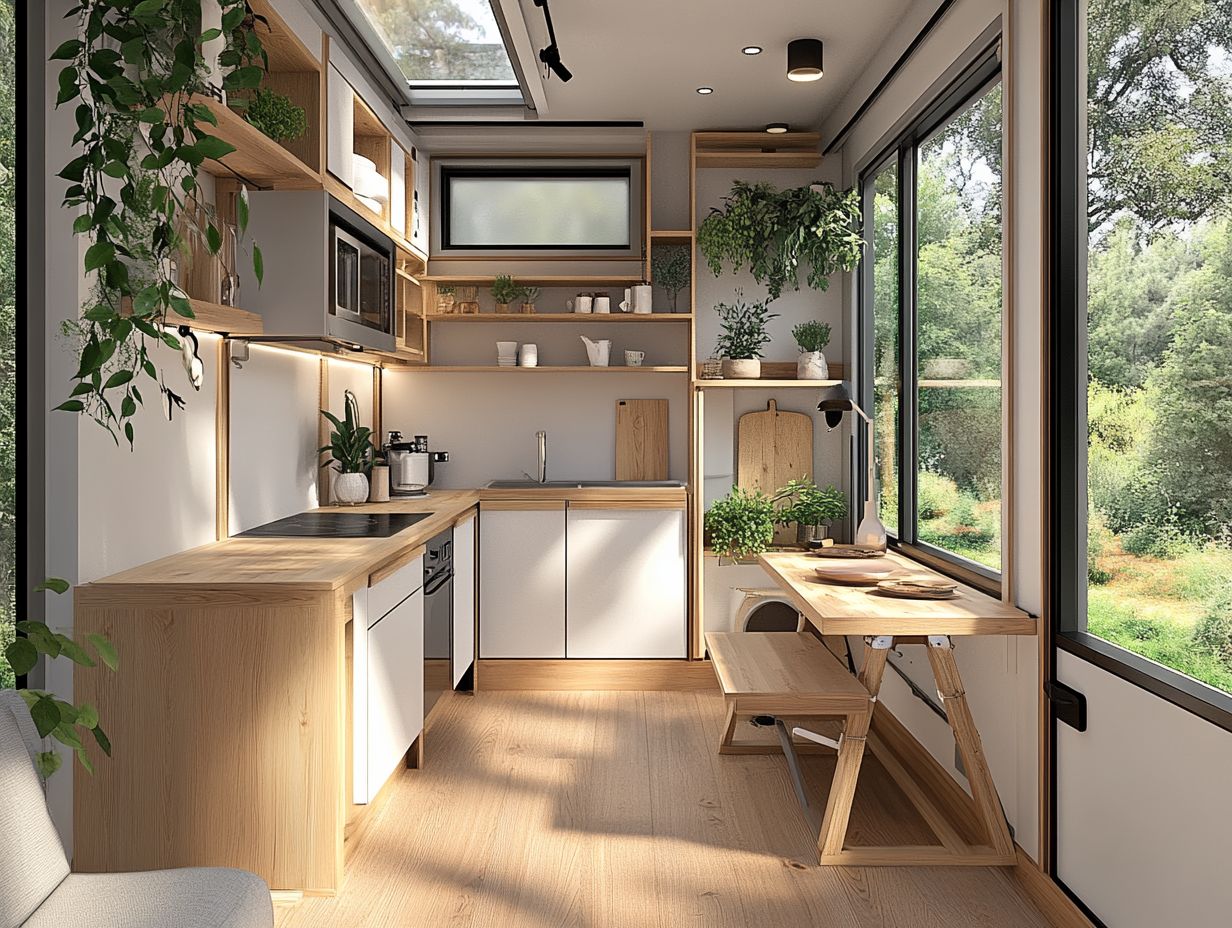
Smart storage solutions are a game changer in tiny homes, enabling you to make the most of your limited space.
These ideas often include clever hidden storage options that enhance your compact living experience while considering the environmental impact of your design choices.
Incorporating multifunctional furniture think ottomans with hidden compartments or beds with drawers underneath allows you to stow away your belongings while keeping your environment organized and serene, a hallmark of the minimalist lifestyle.
The tiny home community is a treasure trove of innovation, inspiring creative adaptations like wall-mounted shelves and pegboards that free up floor space while displaying your personal items in style. For more insights, check out designing for dual purpose to maximize your space effectively.
Customization plays a key role; you can tailor these inventive storage solutions to reflect your unique lifestyle and tastes. This ensures they align with the downsizing trend and makes efficient storage not merely a necessity, but a vital component in elevating the aesthetics and functionality of your living space.
Multi-purpose Furniture
Multi-purpose furniture is essential in tiny home design, offering versatile solutions that support compact living while adhering to sustainability principles.
These innovative pieces not only conserve space but also enhance functionality, ensuring every square inch is utilized to its fullest potential.
Imagine a sofa bed that transforms from a cozy seating area during the day to a comfortable sleeping space at night perfect for small living quarters.
Foldable dining tables provide the flexibility to create a dining area that can easily be tucked away when not in use, thus enhancing your financial management.
By incorporating items like storage ottomans and convertible desks, you can achieve a seamless blend of style and practicality, significantly enhancing the overall livability of your compact space.
Living in a Tiny Home: Challenges and Solutions
Living in a tiny home introduces distinct challenges that demand effective solutions.
You’ll need to master the art of maintaining a minimalist lifestyle, tackle building obstacles with creativity, and tap into community support through groups like The Tiny Life for a truly fulfilling experience. Additionally, exploring sustainable design practices for tiny houses can enhance your living experience.
Maintaining a Minimalist Lifestyle
Maintaining a minimalist lifestyle in a tiny home invites you to make deliberate choices that emphasize quality over quantity. This approach is perfectly in tune with the downsizing trend gaining momentum in modern society.
This method encourages you to assess your belongings and actively remove anything that no longer serves a meaningful purpose. Each item should enrich your living space. By embracing intentional purchasing and choosing natural materials, you thoughtfully consider the necessity and value of each item before bringing it into your home. This fosters a deeper connection with your possessions.
Cultivating a mindset rooted in gratitude and simplicity enhances your appreciation for everyday essentials. This mindset makes it more manageable to resist the temptations of consumerism. As a result, many individuals discover a liberating sense of freedom in decluttering along with increased mental clarity, crucial for navigating the building journey of designing a tiny house for family living.
Dealing with Limited Space
Dealing with limited space in a tiny home can present challenges; however, with innovative design and efficient resource utilization, you can create a livable and enjoyable environment.
To tackle this issue, explore various space-saving solutions like multipurpose furniture, which serves dual functions while keeping clutter at bay. Incorporating vertical storage options such as wall shelves and hooks maximizes your floor space and enhances accessibility. Additionally, consider how to create a tiny house zen space to promote the DIY approach often seen in the tiny home community.
Open floor plans and strategic room layouts can create an illusion of spaciousness, making your area feel larger than it is.
Utilizing under-bed storage, foldable tables, and hidden compartments allows you to efficiently accommodate both your daily needs and personal belongings without sacrificing comfort. This embraces a hands-on approach to your living space.
Frequently Asked Questions
What is a tiny home?
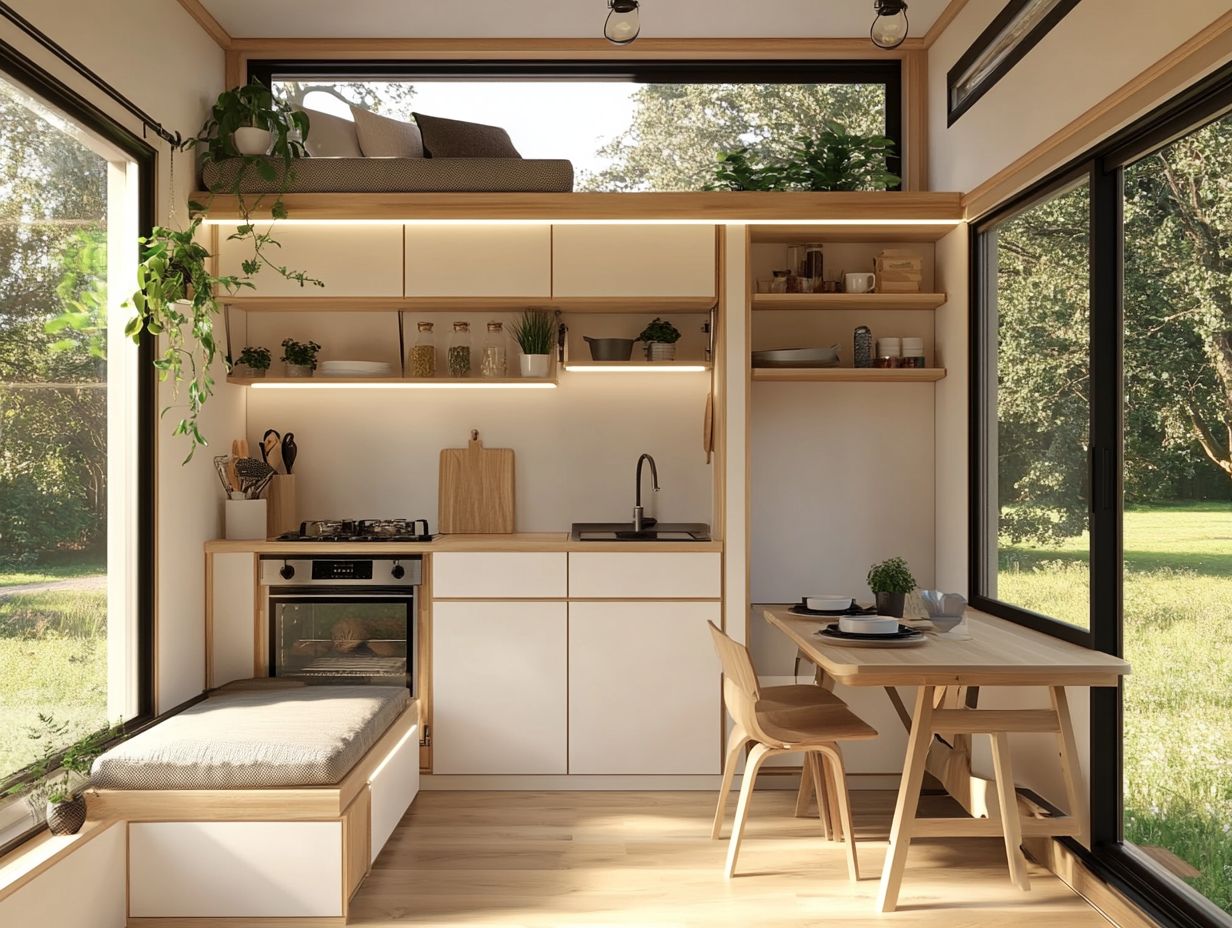
A tiny home is a compact and efficient living space that typically ranges from 100 to 400 square feet. It fulfills all the basic needs of a regular home, such as a kitchen, bathroom, and sleeping area, but on a smaller scale. This offers an opportunity for cost-effective living.
Why is tiny living becoming so popular?
Many people opt for tiny homes to downsize and simplify their lives. Some seek a more affordable housing option, especially as they embrace the DIY movement. Others are attracted to living in a smaller, more eco-friendly home.
What are the benefits of living in a tiny home?
Imagine slashing your bills and enjoying a simpler life living in a tiny home makes it possible! Benefits include lower utility costs, easier upkeep, and a smaller environmental footprint. It also encourages a more intentional lifestyle.
What important factors should I consider when creating a tiny home?
When creating a tiny home, key factors include size and layout, construction methods, and local regulations. It’s crucial to prioritize essential features and amenities while considering energy consumption and reclaimed materials.
Can I build a tiny home on my own?
Yes, it s possible to build a tiny home on your own, but it requires careful planning, research, and construction skills. Seeking guidance from experienced professional builders or attending workshops can be invaluable, especially if considering a trailer foundation.
Are there challenges to living in a tiny home?
Living in a tiny home comes with challenges such as limited space, storage, and potential zoning restrictions. Adjusting to a different lifestyle and mindset focused on transformative living is essential. However, many find this experience rewarding and fulfilling.
Ready to take the plunge into tiny living? Start planning your dream tiny home today!

